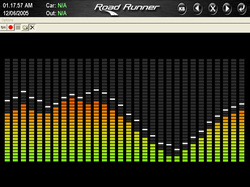
1. Earth's Orbit Song (below)
2. Winter Spring Summer Fall Song (also below)
3. Weight, Mass and Gravity Song (below as well) This song is probably the most difficult to follow, but I HAD to include it. You'll see why. ;)
|
|
 Apparently the same 6th grade teacher who recorded songs for warm fronts and cold fronts has a LOT more science songs. His name is Mr. Parr. Here are three more that are related to the movements of the Earth, as well as the forces at work: 1. Earth's Orbit Song (below) 2. Winter Spring Summer Fall Song (also below) 3. Weight, Mass and Gravity Song (below as well) This song is probably the most difficult to follow, but I HAD to include it. You'll see why. ;)
3 Comments
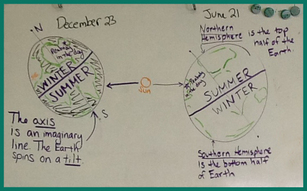 Our seasons change because of 2 main reasons.
First, we revolve around the sun. We are on opposite sides of the sun during winter as we are during summer. Second, the Earth does not spin "standing up" perfectly, the way it does on a basketball player's fingertip. It's tilted on it's axis (which is an imaginary line). Look at the diagram above. Notice that the sun "points" to the bottom half of Earth on the left. When Earth is on that side of the sun, it's summer in the southern hemisphere (bottom half of Earth). Notice on the right that the sun "points" to the top half of Earth. When the Earth is on that side of the sun, it's summer in the northern hemisphere (top half of Earth). Where ever the sun is not pointing at the time is winter. That's why even though it's almost summer for us in the northern hemisphere, it's almost winter in Australia! 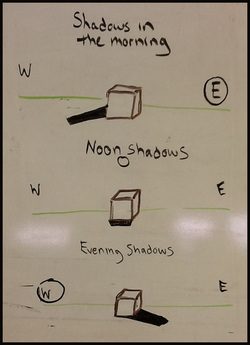 Since the Earth turns once every day, we have noon time once every day. Noon is when we are directly facing the sun.
When we are directly facing the sun, all shadows from sunlight are shorter. The opposite is true at sunrise and sunset. The shadows are longer because the sun appears lower in the sky. Do you think shadows are longer in summer or winter? Think about what you know about where the sun appears in the sky in summer and winter, then leave a comment below. 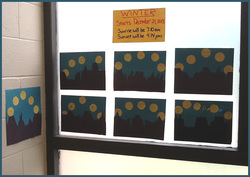 Now that summer is coming, we get more hours of daylight!
Notice the times that the sun rises and sets in Peabody on June 21 as compared to December 21. As a result, the sun appears to be higher in the sky at noon. It also stays out for longer during the daylight hours. Do you like summer or winter better? 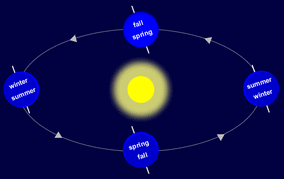 The key to understanding why the seasons change and summer is coming for us soon is to look at how much sunlight is shining on our hemisphere. We are in the northern hemisphere (top half), but Australia is in the southern hemisphere (bottom half). On June 21 when it's summer here, it will be winter there. The video below will show you why. When you watch the video below, remember that those of us in Peabody, Massachusetts, in the United States are all in the northern hemisphere (top half) of the Earth. In that picture, it shows you that in December the top is tilted AWAY FROM the sun, so it's in winter. Notice how much less sunlight our half of the Earth is getting! The bottom half of the Earth (the southern hemisphere) is getting much more sun, so in December it's in summer. 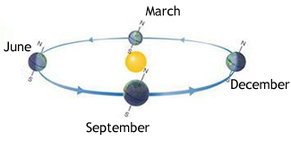 So remember, the tilt of the Earth stays the same. As a result, in June when the top half gets a lot of sunlight which makes summer, but at the same time the bottom half doesn't get as much sunlight so it makes winter.
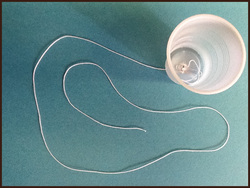 Today Mr. Wahle came to teach us about how we can hear sounds, and how sounds are made. To the left is a "chicken" that makes a clucking noise. What do you think would happen to the sound if you used a bigger cup? Below is a "buzzing bee." What do you think would happen to the sound if we used a longer stick and bigger index card?
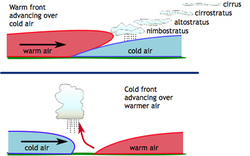 This will be a long post about weather changes that we call fronts! I'll divide it into sections to make it easier to choose parts to read. **1** This site below has a better explanation of warm and cold fronts than your book. However: 1. It has some ads. You shouldn't click on those, because they are off-topic. 2. The song at the top won't teach you as much as reading the text. 3. Click on the arrows at the bottom (near the middle) to get to the next page. 4. When you get to the page on tornadoes, that should tell you that you're in a different chapter. The changeover is abrupt! http://www.kidsgeo.com/geography-for-kids/0126-fronts.php **2** If you would rather watch a video about fronts, here is one with good information: **3** This site will show a scientific demonstration that PROVES warm air rises above cold air (just like warm water rises above cold water). There is a video ad that plays before the demonstration that you have to watch (or mute the sound). http://www.weather.com/video/creating-a-weather-front-19179 **4** This video below is a cartoon, and the characters give a good explanation of fronts, but they make a few little mistakes: 1. They say "it creates some weather," but they mean, "it creates some precipitation. 2. Don't throw a snowball at someone's head, even if you are demonstrating science. Also, they tell you the names of each different warm and cold front in the United States, which is interesting, but won't be on your fourth grade test. :) http://studyjams.scholastic.com/studyjams/jams/science/weather-and-climate/air-masses-and-fronts.htm **5** This video has a great animation of cold and warm fronts: 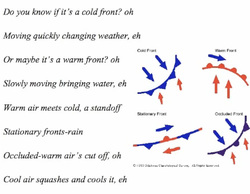 **6** Finally, here is a song that might sound familiar to you. Most of it is very complicated, but the bridge (repeating part, shown left) does tell you about warm and cold fronts! Listen to the video below. 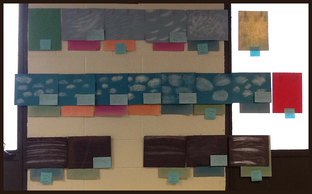 We learned about 3 types of clouds.
Cirrus clouds are high up, and they are created by wind. Cumulus clouds are puffy clouds that form on nice, sunny days. Stratus clouds are low, striped clouds. They appear on grey days and usually form into rain clouds later on. What sort of activities would you plan if you saw Cumulus clouds in the sky? 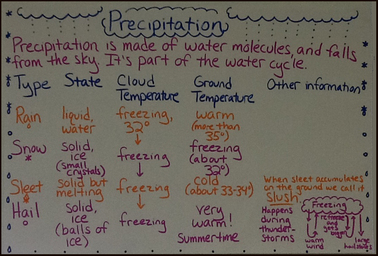 Precipitation is wet weather. It's part of the water cycle. There are 4 main types of precipitation, although you can also get a "wintery mix" of a couple types together. All precipitation comes from clouds, and it's freezing way up there in the clouds, even in the summer time! However the temperature near the ground can cause the freezing precipitation to melt, if it's warm enough. Hail is able to form in the summer because the clouds are freezing, and wind can cause the precipitation to build up in the clouds so much that it doesn't have time to melt before it hits the ground. 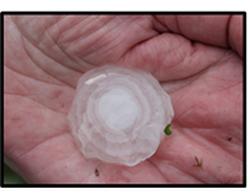 Here is what a large hailstone looks like! They're not all that big. But on this one you can see all the layers where it got wet, blown back up into the cloud where it was freezing, and that repeated over and over before falling to the ground.
Have you ever seen hail before? Answer in the comments below. 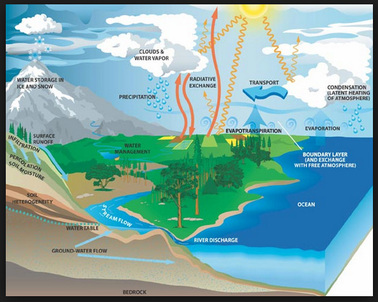 Here is an explanation of the water cycle. Click on this for the whole class to watch, or else use headphones to watch it: Water Cycle Video.
You can see an animated diagram of the water cycle here. There is no sound, but you can take your time reading the labeled parts and watching the arrows move. Look at the words on the right of the pictures. You can click each of these 3 words to learn where the water vapor goes, what each part of the process is called, and arrows showing the direction water takes. |